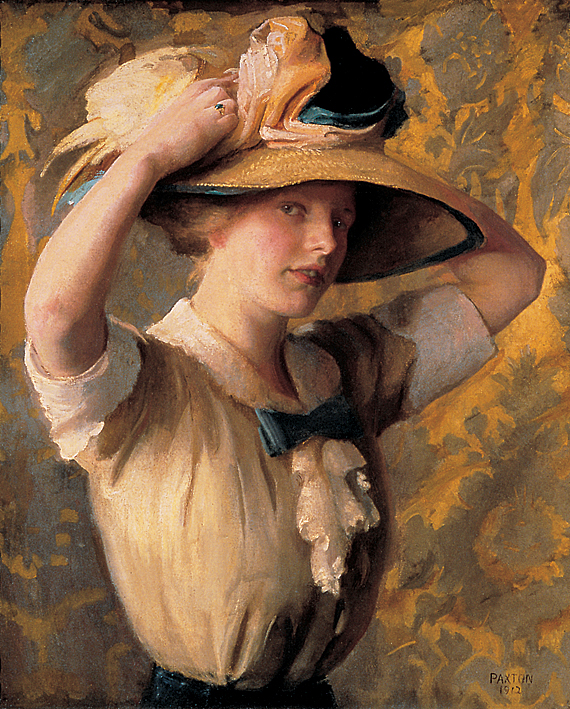
William McGregor Paxton (June 22, 1869 – 1941) was an American Impressionist painter.
Born in Baltimore, the Paxton family came to Newton Corner in the mid-1870s, where William's father James established himself as a caterer. At 18, William won a scholarship to attend the Cowles Art School, where he began his art studies with Dennis Miller Bunker. Later he studied with Jean-Léon Gérôme in Paris and, on his return to Boston, with Joseph DeCamp at Cowles. There he met his future wife Elizabeth Okie, who also was studying with DeCamp. After their marriage, William and Elizabeth lived with his parents at 43 Elmwood Street, and later bought a house at 19 Montvale Road in Newton Centre.
Paxton, who is best known as a portrait painter, taught at the Museum School from 1906 to 1913. Along with other well known artists of the era, including Edmund Charles Tarbell and Frank Weston Benson, he is identified with the Boston School. He was well known for his extraordinary attention to the effects of light and detail in flesh and fabric. Paxton's compositions were most often idealized young women in beautiful interiors. Paxton gained fame for his portraiture and painted both Grover Cleveland and Calvin Coolidge. He taught at the Boston Museum of Fine Arts School from 1906 to 1913. Paxton was made a full member of the National Academy of Design in 1928.
Like many of his Boston colleagues, Paxton found inspiration in the work of the seventeenth-century Dutch painter Johannes Vermeer. Paxton was fascinated not only with Vermeer's imagery, but also with the system of optics he employed. He studied Vermeer's works closely, and discovered that only one area in his compositions was entirely in focus, while the rest were somewhat blurred. Paxton ascribed this peculiarity to "binocular vision," crediting Vermeer with recording the slightly different point of view of each individual eye that combine in human sight. He began to employ this system in his own work, including The New Necklace, where only the gold beads are sharply defined while the rest of the objects in the composition have softer, blurrier edges. This effect is even more noticeable in Paxton's 1915 painting entitled Nude, which shows a young woman seated on a blue dress that is spread across the seat of a backless divan. The woman is shown leaning slightly to the right, reaching for a pink undergarment. The figure is viewed from an angle that is midway between a back view and a right side view. All objects in the painting are slightly blurred with the exception of the woman's one visible breast (the right one) and parts of her right arm. Paxton crafted his elaborate compositions with models in his studio, and the props he used, appear in several different paintings.
Paxton was working on his last painting, a view of his living room at 19 Montvale Road, with his wife posing for him, when he was stricken with a heart attack and died at the age of 72.

{"Girl Combing her Hair" 1909}

{"The String of Pearls", 1908}

{"Portrait of Louise Converse", 1915}

{"Portrait of Charles Sinklar", 1928}

{"Molly Scott and Dorothy Tay", 1898}

{"The Crystal", 1900}

{"The New Necklace", 1910}

{"Portrait of Mr. Charles F. Toppan", 1935}

{"The Sisters", 1904}

{"Child in the Sunlight", 1908}

{"In the Studio", c. 1905}

{"Nausicaa", 1937}
{"The Breakfast", 1911}
{"Rose and Blue", 1913}

{"The Tam", c. 1930s}

{"The Shade Hat", 1912}

{"Sylvia", 1908}

{"The Love Letter", unknowed date (c. last 1890s)}



+13.30.50.png)

+16.41.12.png)
+14.13.26.png)
+13.48.25.png)
+14.40.32.png)